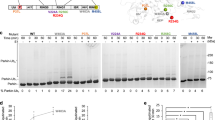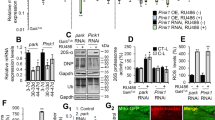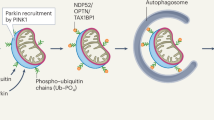Abstract
High temperature requirement A2 (HtrA2/Omi) is a mitochondrial protease that exhibits proapoptotic and cell-protective properties and has been linked to Parkinson's disease (PD). Impaired mitochondrial function is a common trait in PD patients, and is likely to play a significant role in pathogenesis of parkinsonism, but the molecular mechanisms remain poorly understood. Genetic studies in Drosophila have provided valuable insight into the function of other PD-linked genes, in particular PINK1 and parkin, and their role in maintaining mitochondrial integrity. Recently, HtrA2 was shown to be phosphorylated in a PINK1-dependent manner, suggesting it might act in the PINK1 pathway. Here, we describe the characterization of mutations in Drosophila HtrA2, and genetic analysis of its function with PINK1 and parkin. Interestingly, we find HtrA2 appears to be dispensable for developmental or stress-induced apoptosis. In addition, we found HtrA2 mutants share some phenotypic similarities with parkin and PINK1 mutants, suggesting that it may function in maintaining mitochondrial integrity. Our genetic interaction studies, including analysis of double-mutant combinations and epistasis experiments, suggest HtrA2 acts downstream of PINK1 but in a pathway parallel to Parkin.
Similar content being viewed by others
Log in or create a free account to read this content
Gain free access to this article, as well as selected content from this journal and more on nature.com
or
Abbreviations
- HtrA2:
-
high temperature requirement A2
- PD:
-
Parkinson's disease
- PINK1:
-
PTEN induced putative kinase 1
- IAP:
-
inhibitor of apoptosis protein
- mnd2 :
-
motor neuron degeneration
- SAPK:
-
stress-activated protein kinase
- MTS:
-
mitochondrial targeting sequence
- TM:
-
transmembrane domain
- PDZ:
-
postsynaptic density protein (PSD95), disc large, zonula occludens-1
- H2-Opt:
-
HtrA2 optimal
- mRpL11:
-
mitochondrial ribosomal protein-like 11
- STS:
-
staurosporine
- UV:
-
ultraviolet
- IFM:
-
indirect flight muscle
- WT:
-
wild type
- PARL:
-
presenilin-associated rhomboid-like
References
Clausen T, Southan C, Ehrmann M . The HtrA family of proteases: implications for protein composition and cell fate. Mol Cell 2002; 10: 443–455.
Vaux DL, Silke J . Mammalian mitochondrial IAP binding proteins. Biochem Biophys Res Commun 2003; 304: 499–504.
Sohn J, Grant RA, Sauer RT . Allosteric activation of DegS, a stress sensor PDZ protease. Cell 2007; 131: 572–583.
Vaux DL, Silke J . HtrA2/Omi, a sheep in wolf's clothing. Cell 2003; 115: 251–253.
Srinivasula SM, Gupta S, Datta P, Zhang Z, Hegde R, Cheong N et al. Inhibitor of apoptosis proteins are substrates for the mitochondrial serine protease Omi/HtrA2. J Biol Chem 2003; 278: 31469–31472.
Yang QH, Church-Hajduk R, Ren J, Newton ML, Du C . Omi/HtrA2 catalytic cleavage of inhibitor of apoptosis (IAP) irreversibly inactivates IAPs and facilitates caspase activity in apoptosis. Genes Dev 2003; 17: 1487–1496.
van Loo G, van Gurp M, Depuydt B, Srinivasula SM, Rodriguez I, Alnemri ES et al. The serine protease Omi/HtrA2 is released from mitochondria during apoptosis. Omi interacts with caspase-inhibitor XIAP and induces enhanced caspase activity. Cell Death Differ 2002; 9: 20–26.
Martins LM, Iaccarino I, Tenev T, Gschmeissner S, Totty NF, Lemoine NR et al. The serine protease Omi/HtrA2 regulates apoptosis by binding XIAP through a reaper-like motif. J Biol Chem 2002; 277: 439–444.
Igaki T, Suzuki Y, Tokushige N, Aonuma H, Takahashi R, Miura M . Evolution of mitochondrial cell death pathway: proapoptotic role of HtrA2/Omi in Drosophila. Biochem Biophys Res Commun 2007; 356: 993–997.
Challa M, Malladi S, Pellock BJ, Dresnek D, Varadarajan S, Yin YW et al. Drosophila Omi, a mitochondrial-localized IAP antagonist and proapoptotic serine protease. EMBO J 2007; 26: 3144–3156.
Khan FS, Fujioka M, Datta P, Fernandes-Alnemri T, Jaynes JB, Alnemri ES . The interaction of DIAP1 with dOmi/HtrA2 regulates cell death in Drosophila. Cell Death Differ 2008; 15: 1073–1083.
Jones JM, Datta P, Srinivasula SM, Ji W, Gupta S, Zhang Z et al. Loss of Omi mitochondrial protease activity causes the neuromuscular disorder of mnd2 mutant mice. Nature 2003; 425: 721–727.
Martins LM, Morrison A, Klupsch K, Fedele V, Moisoi N, Teismann P et al. Neuroprotective role of the Reaper-related serine protease HtrA2/Omi revealed by targeted deletion in mice. Mol Cell Biol 2004; 24: 9848–9862.
Strauss KM, Martins LM, Plun-Favreau H, Marx FP, Kautzmann S, Berg D et al. Loss of function mutations in the gene encoding Omi/HtrA2 in Parkinson's disease. Hum Mol Genet 2005; 14: 2099–2111.
Ross OA, Soto AI, Vilarino-Guell C, Heckman MG, Diehl NN, Hulihan MM et al. Genetic variation of Omi/HtrA2 and Parkinson's disease. Parkinsonism Relat Disord 2008; 14: 539–543.
Simon-Sanchez J, Singleton AB . Sequencing analysis of OMI/HTRA2 shows previously reported pathogenic mutations in neurologically normal controls. Hum Mol Genet 2008; 17: 1988–1993.
Bogaerts V, Nuytemans K, Reumers J, Pals P, Engelborghs S, Pickut B et al. Genetic variability in the mitochondrial serine protease HTRA2 contributes to risk for Parkinson disease. Hum Mutat 2008; 29: 832–840.
Plun-Favreau H, Klupsch K, Moisoi N, Gandhi S, Kjaer S, Frith D et al. The mitochondrial protease HtrA2 is regulated by Parkinson's disease-associated kinase PINK1. Nat Cell Biol 2007; 9: 1243–1252.
Whitworth AJ, Lee JR, Ho VM, Flick R, Chowdhury R, McQuibban GA . Rhomboid-7 and HtrA2/Omi act in a common pathway with the Parkinson's disease factors Pink1 and Parkin. Dis Model Mech 2008; 1: 168–174.
Yun J, Cao JH, Dodson MW, Clark IE, Kapahi P, Chowdhury RB et al. Loss-of-function analysis suggests that Omi/HtrA2 is not an essential component of the PINK1/PARKIN pathway in vivo. J Neurosci 2008; 28: 14500–14510.
Park J, Lee SB, Lee S, Kim Y, Song S, Kim S et al. Mitochondrial dysfunction in Drosophila PINK1 mutants is complemented by parkin. Nature 2006; 441: 1157–1161.
Clark IE, Dodson MW, Jiang C, Cao JH, Huh JR, Seol JH et al. Drosophila pink1 is required for mitochondrial function and interacts genetically with parkin. Nature 2006; 441: 1162–1166.
Yang Y, Gehrke S, Imai Y, Huang Z, Ouyang Y, Wang JW et al. Mitochondrial pathology and muscle and dopaminergic neuron degeneration caused by inactivation of Drosophila Pink1 is rescued by Parkin. Proc Natl Acad Sci USA 2006; 103: 10793–10798.
Pesah Y, Pham T, Burgess H, Middlebrooks B, Verstreken P, Zhou Y et al. Drosophila parkin mutants have decreased mass and cell size and increased sensitivity to oxygen radical stress. Development 2004; 131: 2183–2194.
Whitworth AJ, Theodore DA, Greene JC, Benes H, Wes PD, Pallanck LJ . Increased glutathione S-transferase activity rescues dopaminergic neuron loss in a Drosophila model of Parkinson's disease. Proc Natl Acad Sci USA 2005; 102: 8024–8029.
Greene JC, Whitworth AJ, Andrews LA, Parker TJ, Pallanck LJ . Genetic and genomic studies of Drosophila parkin mutants implicate oxidative stress and innate immune responses in pathogenesis. Hum Mol Genet 2005; 14: 799–811.
Greene JC, Whitworth AJ, Kuo I, Andrews LA, Feany MB, Pallanck LJ . Mitochondrial pathology and apoptotic muscle degeneration in Drosophila parkin mutants. Proc Natl Acad Sci USA 2003; 100: 4078–4083.
Riparbelli MG, Callaini G . The Drosophila parkin homologue is required for normal mitochondrial dynamics during spermiogenesis. Dev Biol 2007; 303: 108–120.
Chao JR, Parganas E, Boyd K, Hong CY, Opferman JT, Ihle JN . Hax1-mediated processing of HtrA2 by Parl allows survival of lymphocytes and neurons. Nature 2008; 452: 98–102.
Bradham C, McClay DR . p38 MAPK in development and cancer. Cell Cycle 2006; 5: 824–828.
Colombani J, Polesello C, Josue F, Tapon N . Dmp53 activates the Hippo pathway to promote cell death in response to DNA damage. Curr Biol 2006; 16: 1453–1458.
Acknowledgements
We thank J Chung and the Bloomington Drosophila Stock Center for fly stocks, T Gilbank, S Murray and F Earl for fly transgenics, G Kelly for help with statistical analysis, C Gray for help with movies and K Klupsch for comments on the article. We are grateful to M Guo for sharing data before publication. AW and LT acknowledge the Department of Biomedical Science, Centre for Electron Microscopy for assistance, and the Light Microscopy Facility is supported by the Wellcome Trust (Grant No. GR077544AIA). AW is funded by the Parkinson's Disease Society (G-4063, G-0713) and the Wellcome Trust (081987). The MRC Centre for Developmental and Biomedical Genetics is supported by Grant G070091. LMM is supported by the MRC (UK). Work in the Tapon and Downward laboratories is supported by Cancer Research UK. HPF is supported by the MRC Grant G0700183.
Author information
Authors and Affiliations
Corresponding authors
Additional information
Edited by E Baehrecke
Supplementary Information accompanies the paper on Cell Death and Differentiation website (http://www.nature.com/cdd)
Rights and permissions
About this article
Cite this article
Tain, L., Chowdhury, R., Tao, R. et al. Drosophila HtrA2 is dispensable for apoptosis but acts downstream of PINK1 independently from Parkin. Cell Death Differ 16, 1118–1125 (2009). https://doi.org/10.1038/cdd.2009.23
Received:
Revised:
Accepted:
Published:
Issue date:
DOI: https://doi.org/10.1038/cdd.2009.23
Keywords
This article is cited by
-
Curcuma longa L. Prevents the Loss of β-Tubulin in the Brain and Maintains Healthy Aging in Drosophila melanogaster
Molecular Neurobiology (2022)
-
DNase II mediates a parthanatos-like developmental cell death pathway in Drosophila primordial germ cells
Nature Communications (2021)
-
Apoptosis in Drosophila: which role for mitochondria?
Apoptosis (2016)
-
Compromised MAPK signaling in human diseases: an update
Archives of Toxicology (2015)
-
The protease Omi regulates mitochondrial biogenesis through the GSK3β/PGC-1α pathway
Cell Death & Disease (2014)



